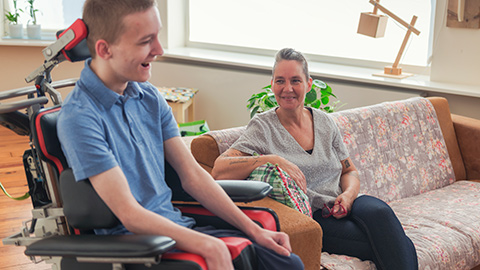
A client with amyotrophic lateral sclerosis (ALS), a progressive and ultimately terminal nervous system disease, is getting amazing results with massage and other interventions. How is this possible?
ALS is a serious situation, but if the client can communicate clearly, it is a great match for massage. Listen in to hear what this therapist has seen happen over the course of their work together.


Books of Discovery:www.booksofdiscovery.com
Anatomy Trains:www.anatomytrains.com
Anatomy Trains is a global leader in online anatomy educationand alsoprovides in-classroom certification programs forstructuralintegration in the US, Canada, Australia,Europe, Japan, and China, as well as fresh-tissue cadaverdissectionlabs and weekend courses. The work of Anatomy Trains originated with founder Tom Myers, who mapped the human body into 13 myofascial meridians in his original book, currently in itsfourthedition and translated into 12 languages. The principles of Anatomy Trains are used by osteopaths, physical therapists, bodyworkers, massage therapists, personal trainers, yoga, Pilates,Gyrotonics, and other body-minded manual therapists and movement professionals. Anatomy Trains inspires these practitioners to work with holisticanatomy in treating system-wide patterns to provide improved client outcomes in terms of structure and function.
Website:anatomytrains.com
Email:info@anatomytrains.com
Facebook:facebook.com/AnatomyTrains
Instagram: www.instagram.com/anatomytrainsofficial
YouTube:https://www.youtube.com/channel/UC2g6TOEFrX4b-CigknssKHA
0:00:01.2 Ruth Werner: Hey, I Have A Client Who listeners, did you know I have a growing library of NCB approved one-hour online self-paced continuing education courses that you can do any time, anywhere? Well, now you know. Current classes include, what's next? COVID-19 updates from massage therapists and a massage therapist's Introduction to Pharmacology Part one, and brand new, a massage therapist's Introduction to Pharmacology part two. Classes are $20 each, and they confer one hour of continuing education credit. Wanna know more? Visit my website at RuthWerner.com and check it out. Be sure to sign up for my mailing list so you'll never miss a new class.
0:00:47.6 RW: Anatomy Trains is delighted to invite you to our in-person fascial dissection workshop, May 30th through June 3rd, 2022. We're excited to be back in the lab with Anatomy Trains author, Tom Myers, and master dissector, Todd Garcia, in Todd's laboratory of anatomical enlightenment in Boulder, Colorado. Join students from around the world and from all types of manual movement and fitness professions to explore the real human form, not the images you get from books. Visit anatomytrains.com for details.
[music]
0:01:33.5 RW: Hi, and welcome to I Have A Client Who, pathology conversations with Ruth Werner, the podcast where I will discuss your real life stories about clients with conditions that are perplexing or confusing. I'm Ruth Warner, author of A Massage Therapist's Guide to Pathology, and I have spent decades studying, writing about and teaching about where massage therapy intersects with diseases and conditions that might limit our client's health. We almost always have something good to offer even with our most challenged clients, but we need to figure out a way to do that safely, effectively and within our scope of practice. And sometimes, as we have all learned, that is harder than it looks.
0:02:19.7 RW: Today's lovely I Have A Client Who story was shared by a massage therapist who has this to say: "Hi, Ruth. I have an amazing client, one of the most resilient people I know. He was diagnosed with ALS six years ago. According to statistics, he should be dead because usually they die one to two years after diagnosis. He is extremely proactive. Just before his diagnosis, he was going to be promoted to CEO of a global company that we all know, but then he decided to retire because he knew that he wouldn't be able to take care of himself the way he was supposed to. He gets acupuncture every Friday, and he sees me every Wednesday for Thai massage. The ALS affects his walking, so he uses two braces. When he first came in, he was leaning forward and dragging his feet, walking slowly, he's been getting great results with Thai massage.
0:03:17.5 RW: He is standing more upright, he's walking a little bit quicker and barely has any pain at all, his arms would not straighten more than 90 degrees because the fascia was so tight from using the braces. Now, they're almost straight. I do a lot of core work with him, iliopsoas and so on. He books everything else in his life around his Thai massage. Sometimes we do cupping and some hot stones while on the mat, not only has the ALS not progressed, he's actually reversing some of the myofascial tension. Of course, this is a combination of everything he does, including having an anti-inflammatory diet, gluten-free, getting acupuncture regularly, he has a pool in his house and swims daily. And one of the things he noticed after we started working on his core is that when he's swimming, before, he used to drag his legs, and now he's kicking." Wow, don't you love to hear stories like this? It puts a little different perspective on one of the most dire diagnosis a person can get, amyotrophic lateral sclerosis or ALS, which is also known as Lou Gehrig's disease. And in Britain, it's called motor neuron disease. So in this episode, we're gonna do a little background on ALS, which has some surprising ways in which massage can be helpful, and then we can discuss what might be going on for this client who is so lucky to have the resources and the wherewithal to take such good care of himself, and also to receive the best possible care for his situation.
0:04:54.1 RW: Sadly, that is not true of many people who live with this disease. ALS has been around for a long time, but it became well known when one of the most famous baseball players of his generation began to lose coordination in his hands and feet. Diagnosed with ALS on his 36th birthday, Lou Gehrig, a famous baseball player from the mid-1930s, famously announced in an impromptu speech in which he was thanking all the people who had supported him. "For the past two weeks, you've been reading about a bad break, yet today, I consider myself the luckiest man on the face of the earth." He died two years after his diagnosis. ALS has a surprisingly large presence in popular culture.
0:05:40.9 RW: We're all familiar with the British physicists and cosmologists, Stephen Hawking. He lived with Motor Neuron Disease for 55 years, which is very unusual. ALS was the subject of a best-selling book, Tuesdays With Morrie, it has even touched our own massage community. We lost Niner Macintosh author of the wonderful ethics book, The Educated Heart in 2010 because of this terminal disease. And yes, I am sorry to say, it is a terminal disease. Often it progresses quickly, sometimes not. So the main goals for a person with this diagnosis is to focus on quality of life and preserving function for as long as possible, which you heard reflected in the description that our contributor gave us. But I'm getting a little bit ahead of myself, so let's step back and talk about what's happening with this central and peripheral nervous system disorder, so we can maybe think about how massage in various forms might be helpful to meet those goals of preserving function and adding to the quality of life.
0:06:48.0 RW: ALS, amyotrophic lateral sclerosis. What can you derive from this name? Amyotrophic means absence of muscle growth, or what we're really getting at here is, muscle atrophy. And lateral sclerosis, what? Scarring on the outside of something? The muscles? Well, no, not quite, this reflects the observation of damage and scarring that's sclerosis, of course, at the lateral aspects of the spinal cord, which is where the motor tracts descend from the brain toward the spinal nerves. This condition was first described in 1869 by an extremely notable French neurologist, Jean-Matin Charcot. Charcot was also early to describe multiple sclerosis and several other neurological issues, and he influenced much of the late 19th century exploration of human anatomy and especially of the nervous system. But back to ALS, amyotrophic lateral sclerosis is, I'm happy to say, a relatively rare disease. In the United States, it's diagnosed between 5000 and 6000 times a year, and we think that right now, there are about 20,000 people who live with this condition at any particular time.
0:08:11.4 RW: This disease involves damage to motor neurons in the central and peripheral nervous systems. We don't know what causes that damage, theories include genetic mutations, environmental exposures, maybe some issues with metabolism, oxidative injury, mitochondrial dysfunction, too much glutamate, which is an excitatory neurotransmitter. All of these are possible contributors, and of course, it may be multifactorial, where we get layers of contributors on top of each other. ALS happens among military veterans more than in the general population, and there are some isolated areas where it appears to run in family or ethnic lines, Guam and the Mariana Islands and some locations in Japan, for instance. In the United States, we see it can run in families, but it's usually a sporadic situation here with no family precedents.
0:09:04.9 RW: Alright, so for whatever reason, motor neurons in the brain and the spinal cord and the spinal nerves degenerate with amyotrophic lateral sclerosis. There's also evidence of some changes in the frontal lobe, which results in problems with executive function and emotional regulation as well. As those motor neurons degenerate, control of skeletal muscles is lost, and the muscle cells atrophy. This has to go pretty far before any atrophy is visible, about a third of the motor supply has to be gone, but you can imagine what this means for strength and coordination. There are several presentations of ALS, but the most common one involves the greatest loss of muscle function in the extremities first, hands and feet, and then it moves approximately to affect the arms and the legs, finally the trunk, including the breathing muscles and the muscles that control swallowing and speech.
0:10:03.0 RW: Did you hear the part about ALS where sensory nerves are attacked as well? You didn't, because they aren't, and that has important issues for massage therapy. ALS can be painful, but the pain is a secondary issue. As the muscles degenerate, the body collapses and that hurts. Many patients also have painful and unpredictable spasms, and of course, as the body changes, this may lead to new movement and compensation patterns that also are painful. But the pain people have with ALS is not related to a direct attack on sensory neurons and they don't have numbness, and these are issues that make ALS safer for massage therapy than some other neurological issues where those responses are not always reliable.
0:10:54.0 RW: So here we are with this fairly rare, always progressive, always terminal condition that kills off motor neurons in the central and peripheral nervous systems, which leads to atrophy of muscles, and that eventually affects the muscles of respiration. The average life expectancy from diagnosis to death with ALS is somewhere between two to 10 years, the median is about three years. People with ALS also have to deal with a risk of deep vein thrombosis and pressure sores and secondary infections and potentially dangerous problems with their saliva production and an impaired cough reflex, because that is a set up for aspiration pneumonia. The good news, if we can call it good news, is that new treatment options for ALS are always in development, and if you participated in any of those ALS ice bucket challenges from several years ago, then you contributed to this work.
0:11:54.2 RW: I did one of those ice bucket challenges, by the way, but instead of an ice bucket, I submerged myself in the Pacific Northwest ocean, and that was super fun. For now, people with this disease use drugs that suppress too much glutamate production, they may also use muscle relaxants or Botox injections if they have spasms, and a number of other options are available for other secondary kinds of symptoms. So there's our quick sketch of amyotrophic lateral sclerosis. Now, let's return to our client, and as you listen to this, I invite you to think about three things: Number one, ALS isn't inherently painful, but the changes it causes can lead to pain.
0:12:36.8 RW: Number two, ALS does not impair sensation, and that makes it relatively safe for massage as long as the client can communicate clearly about their comfort. And number three, the nervous system, especially in the context of proprioceptors, is remarkably adaptable, and not always in a good way. So to review, here's what our contributor sent in, she said, "The ALS affects his walking, so he uses two braces. When he first came in, he was leaning forward and dragging his feet slowly, he's been getting great results with Thai massage, he's standing more upright, he's walking a little bit quicker and barely has any pain at all. His arms would not straighten more than 90 degrees because the fascia was so tight from using the braces. Now, they're almost straight. I do a lot of core work with him, iliopsoas and so on. Sometimes we do cupping and some hot stones while on the mat. Not only has the ALS not progressed, he's actually reversing some of the myofascial tension. Of course, this is a combination of everything he does, including having an anti-inflammatory diet, he's gluten-free, he gets acupuncture regularly, he has a pool in his house and swims daily, and one of the things that he noticed after we started working on his core is that when he's swimming, before, he used to drag his legs, and now he's kicking on his own." I'm so glad to hear about this kind of success, and I want to offer a bit of a guess about why it may be happening.
0:14:11.4 RW: You will recall that our proprioceptors are sensory neurons that tell us about our position in space. The angle of our joints, the tightness of our muscles, and how much work it takes to do specific tasks. Our proprioceptors are also notoriously easy to fool. If they develop specific sensory pathways that elicit specific motor responses, even if those pathways are not the most efficient or functional, we tend to stick with those habits, whether we want to or not, and the muscles and fascial wrappings just have to go along for the ride. And I wonder if this explains what happened for this client's arms as he received Thai massage, which puts a lot of focus on range of motion. Possibly, it helped to reset those tension levels in his arms, so he could move more easily and more efficiently.
0:15:04.5 RW: And the attention this massage therapist brought to the client's core muscles along with whatever other work he does to stay fit, may well have influenced his strength and stamina with his swimming. Can massage be part of a plan to prolong function and improve this person's quality of life? Well, absolutely, as we see here. And I'm happy to say that this is not the only ALS anecdote like this that I've heard. Over the years, many massage therapists have shared inspiring stories about their clients and about what a privilege it was to be with them on this part of their journey. I wanna thank this contributor for sharing this inspiring story about their terrific and motivated client, and I'd like to invite you.
0:15:49.6 RW: Do you have any stories about clients who have inspired you as they have dealt with special pathology-related challenges? If you do, I'd love to share them so that we can all be encouraged.
0:16:03.8 RW: Hey everybody, thanks for listening to I Have A Client Who pathology conversations with Ruth Werner. Remember, you can send me your I Have A Client Who stories to, ihaveaclientwho@abmp.com. That's, ihaveaclientwho, all one word, all lowercase, @abmp.com. I can't wait to see what you send me, and I'll see you next time.